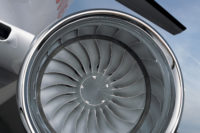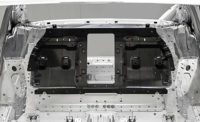As aerospace engineers attempt to create products that can fly faster, higher and more efficiently, new types of materials are essential. Ceramic matrix composites (CMCs) hold tremendous promise. However, they can be difficult to join.
CMCs are made of coated ceramic fibers surrounded by a ceramic matrix. They are tough, lightweight and capable of withstanding temperatures 300 to 400 F hotter than metal alloys can endure. Because of those qualities, they are ideal for jet engine applications.
Engineers at CFM International recently turned to CMC when they designed the new Leap engine, which is used on next-generation Airbus A320neo and Boeing 737MAX jetliners. It features a CMC turbine shroud so that the engine can operate at up to 2,400 F.
By keeping more heat inside the engine, commercial jetliners can use less fuel and emit fewer emissions. The CMC component also needs 20 percent less cooling air than traditional nickel or titanium super alloys.
Engineers at GE Aviation are currently developing a jet engine that will contain five CMC parts—two combustor liners, two nozzles and one shroud. The GE9X engine will power Boeing’s next-generation 777X jetliner.
“A ceramic matrix composite is different than almost all other composites because the matrix is ceramic and the fiber is ceramic,” says Rick Lowden, an engineer at Oak Ridge National Laboratory (ORNL) who helped develop the technology several decades ago. “Typically, combining two brittle materials yields a brittle material.
“But, altering the bond between fiber and matrix allows the material to act more like a piece of wood,” explains Lowden. “Cracks don’t propagate into the fibers from the matrix around them. The fibers hold the material together and carry the load while slowly pulling from the matrix, adding toughness.”
The next step in the evolution of CMCs is to develop a way to make the material withstand even higher temperatures. Engineers at ORNL and the U.S. Advanced Ceramics Association hope to eventually push the heat limit up to 2,700 F.
But, various assembly challenges are holding back the widespread adoption of CMCs for aerospace applications.
“A critical issue for wider use of CMC is the development of cheap, user-friendly joining methods to assemble large components into more complex structures,” says Alber Sadek, technology lead for materials engineering at EWI. “[That requires] joint properties comparable to base materials, including good mechanical strength, oxidation and corrosion resistance, good thermal shock resistance and leak-tight joints.
“Typical ceramic joints will have a combination of stresses under operating conditions,” adds Sadek. “High shear strength is one of the essential requirements.”
According to Sadek, CMCs can be joined to dissimilar materials such as aluminum, steel or titanium. “However, the application of newly developed CMCs is being severely handicapped by the general inability to readily join these materials to other composite materials or to metal structural members,” he warns.
“The preferred methods for joining CMC depend principally on the material of reinforcement, since this material largely affects elevated temperature serviceability because of its inherent melting temperature or its reactivity with the matrix upon heating,” says Sadek.
“In many elevated temperature applications using CMCs, there is a requirement to join them to other materials including metals,” explains Sadek. “Brazing is a highly effective joining technique for many ceramic-metal joint systems.”
“The differences in coefficients of thermal expansion between CMC and metal require specialized approaches to accommodate the mechanical stresses introduced by joining,” Sadek points out. “This can be achieved by flexible or ductile interlayers, or by careful selection of interlayers [with expansion coefficients] matched to the ceramic.
“Nonmelting materials, such as ceramic particles, can be dispersed in the [brazing filler metal] to adjust its thermal expansion coefficient or ductility,” adds Sadek.



